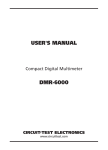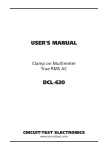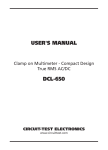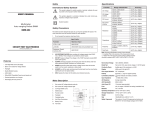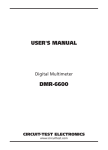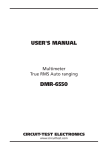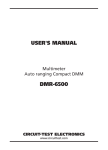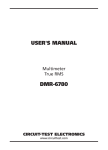Download Circuit-test DMR-1100 User`s manual
Transcript
USER'S MANUAL Digital Multimeter DMR-1100A CIRCUIT-TEST ELECTRONICS www.circuittest.com INTRODUCTION Your Circuit-Test DMR-1100A Digital Multimeter incorporates the latest technology to provide you with a feature packed instrument. With it you can measure a wide range of voltages, current and resistance in the lab, shop, car and home. This product has been designed for the electrician, technician and hobbyist. SAFETY INFORMATION This meter conforms to IEC-61010 for Category I 600V and pollution degree 2. This meter is designed for indoor use only and proper guidelines must be followed for personal and product safety. Per IEC1010 over installation category, equipment of overvoltage Category I is equipment for connection to circuits in which measures are taken to limit the transient overvoltages to an appropriate low level. Examples include protected electronic circuits. Note: Do not use this meter for measurements within overvoltage Category II, III and IV. SAFETY SYMBOLS This symbol adjacent to another symbol, terminal or operating device indicates that the operator must refer to an explanation in the Operating Instructions to avoid personal injury or damage to the meter. This symbol adjacent to one or more terminals identifies them as being associated with ranges that may, in normal use, be subjected to particularly hazardous voltages. For maximum safety, the meter and its test leads should not be handled when these terminals are energized. 2 This symbol advises the user that the terminal(s) so marked must not be connected to a circuit point at which the voltage with respect to earth ground exceeds (in this case) 600 VAC or VDC. WARNING 1. Set the function switch correctly before making any measurements. 2. Do not operate the unit unless the case is completely closed. 3. Disconnect test leads from equipment before removing the battery. 4. Never connect unit to AC or DC powered circuits when function switch is set to Ω, diode check or continuity. 5. To safeguard against electrical shock or damage to instrument, never connect to more than 600V DC or 600V AC between input jacks and ground. 6. Always inspect the instrument, test leads and other accessories for damage prior to use. 7. Read this instruction manual carefully and completely before using. SAFETY PRECAUTIONS High voltage AC and DC circuits are dangerous. Always consider circuits to be energized. Never assume any equipment is de-energized. Lack of caution or poor safety practices can be very dangerous and/or lethal. 3 FEATURES Diode Check - test diodes and other semiconductors for open and short circuits. Overload Protection - protects the meter from overvoltage. Auto-Polarity - indication on display that polarity is reversed. Battery Test - 1.5V and 9V batteries. FRONT PANEL 2 1 20 V 200 600 OFF 600 ~ V 200 2000 μ 20 m 2000 m A 200 m 200 m 2000 k 200 k 10A Ω 1.5V 20k BATT. 2000 9V 200 CIRCUIT-TEST 10A UNFUSED 10A MAX For 10 sec. MAX every 15 min. VΩ mA DMR-1100A DIGITAL MULTIMETER FUSED 200mA 250V ~ MAX 600V ~ MAX COM CAT I 600V 5 4 3 1. Function Switch - Select desired function and range and to turn the meter ON and OFF. 2. LCD Display - 3 ½ Digit 3. COM Jack - Plug-in terminal for black test lead 4. VΩmA Jack - Plug-in terminal for red test lead, for all measurements except DC current measurement ≥ 200mA. 5. 10A Jack - Plug-in terminal for red test lead for DC current measurement between 200mA to 10A. Note: There is no fuse protection for this jack input. 4 SPECIFICATIONS a. GENERAL Display: 3.5 digit, 0.5" (12mm) H LCD Polarity: Automatic, minus (-) sign indicates negative polarity Ranging: Over range: Low Battery: Manual ranging "1" is displayed " " or "BAT" indicates low battery Input Impedance: 1M Ω (DCV/ACV) Sampling Rate: About 2 to 3 times/sec. Storage Temp.: -10 to 50oC Power Source: 1 - 9V Battery Operation Temp.: 0 to 40oC Fuse: Dimensions: Weight: GMA 250mA/250V 70(W) x 127(H) x 25(D)mm 170g (including battery) b. TECHNICAL Note: Accuracy is stated at 65°F to 83°F (18°C to 28°C) and less than 75% RH. Accuracy is: ± ([ % of reading] + [Number of least significant digits]) 5 DC VOLTAGE RANGE RESOLUTION ACCURACY 200mV 100μV ± (0.5% + 5) 2000mV 1mV 20V 10mV 200V 100mV 600V 1V Input Impedance: ± (0.8% + 5) ± (1.0% + 5) 1M Ω Max. Allowable Input Voltage: 600V DC/AC rms AC VOLTAGE RANGE RESOLUTION 200V 100mV 600V 1V Input Impedance: ACCURACY ± (1.2% + 10) 1M Ω Frequency Response: 45Hz - 400Hz Max. Allowable Input Voltage: 600V AC rms 6 DC CURRENT RANGE RESOLUTION 2000μA 1μA 20mA 10μA 200mA 100μA ± (1.2% + 5) 10A 10mA ± (2.0% + 5) Overload Protection: ACCURACY ± (1.0% + 5) Fuse, 250mA/250V, Fast (for the "VΩ inputs only) mA" terminal's There is no fuse protection for the "10A" terminal's inputs. Max. Allowable Input Current: 10A (For inputs > 2A : measurement duration < 10 secs, interval > 15 minutes) RESISTANCE RANGE RESOLUTION ACCURACY 200Ω 0.1Ω ± (1.2% + 5) 2000Ω 1Ω 20kΩ 10Ω 200kΩ 100Ω 2000kΩ 1kΩ Max. Open Circuit Voltage: 7 ± (1.0% + 5) ± (1.2% + 5) about 3V DIODE AND CONTINUITY RANGE DESCRIPTION Test Voltage: about 2.8V Test Current: about 1mA The approximate forward voltage drop in mV will be displayed. The built-in buzzer will sound when the resistance is less than about 50Ω BATTERY TEST RANGE DESCRIPTION 1.5V The working voltage of the battery will be displayed on the LCD. 9V 8 TEST CONDITION The working current is about 20mA. The working current is about 5mA. MEASUREMENTS Please take a few minutes to read these instructions prior to use. 1 DC VOLTAGE MEASUREMENT WARNING: Maximum input is 600V DC. 1-1Plug the red test lead into the V jack and the black test lead into the COM jack. 1-2Set the range switch to the desired position. It is best to start with the highest range if the voltage is not known. 1-3Attach the test leads to the circuit to be measured. Ensure that the black lead is connected to the negative side of the circuit and the red lead to the positive. 1-4Read the displayed voltage. 1-5If the minus(-) sign appears the voltage is negative at the point being measured. 2 AC VOLTAGE MEASUREMENT WARNING: Maximum input is 600V AC. 2-1Plug the red test lead into the V jack and the black test lead into the COM jack. 2-2Set the range switch to the desired position. It is best to start with the highest range if the voltage is not known. 2-3Attach the test leads to the circuit to be measured. 2-4Read the displayed voltage. 9 3 RESISTANCE MEASUREMENT WARNING: Remove all power from the circuit being tested when checking resistance. Discharge any charged capacitors. Never connect the probes to any voltage while the selector is set to OHM. 3-1Plug the red test lead into the V jack and the black test lead into the COM jack. 3-2Set the range switch to the desired Ω position. If the resistance is not known, set the switch to highest range and reduce until a satisfactory reading is obtained. 3-3Attach the test leads to the circuit. 3-4Read the displayed resistance. NOTE: For measurements > 1M Ω the meter may take a few seconds to stabilize reading. This is normal for high resistance measurements. When input is not connected, i.e. open circuit, "1" will be displayed to indicate over range. 4 DC CURRENT MEASUREMENT WARNING: Remove all power from the circuit being tested when checking current. When using 10A scale, do not connect to circuit for more than 10 seconds. 4-1Plug the red test lead into the mA jack and the black test lead into the COM jack if the current to be measured is less than 200mA. Insert the red test lead into the 10A jack if current being measured is between 200mA and 10A. 10 4-2Set the range switch to one of the current ranges. If you are unsure of the amount of current being measured set switch to the highest reading and reduce until a satisfactory reading is obtained. 4-3Remove power from the circuit that is to be measured. Open up the circuit and connect the black lead to the negative side and the red lead to the positive side of the circuit so that the test leads are in series with the load to be measured. 4-4Apply power to the circuit. 4-5Read the displayed current. NOTE: If changing range switch to or from the 10A position first disconnect power and test leads from the circuit being tested. Repeat the above steps using the correct input jack and range switch position. 5 DIODE TEST WARNING: Remove all power from the circuit being tested when using the diode check. Discharge any charged capacitors. Never connect the probes to any voltage while the selector is set to . 5-1Plug the red test lead into the V jack and the black test lead into the COM jack. 5-2Set the function switch to 11 . 5-3 Connect the red test lead to the anode and the black test lead to the cathode of the diode to be tested. 5-4 The approximate forward voltage drop of the diode will be displayed in mV. If the connection is reversed “1” will be displayed. 6 CONTINUITY TEST WARNING: Remove all power from the circuit being tested when checking continuity. Discharge any charged capacitors. Never connect the probes to any voltage while the selector is set to . 6-1 Plug the black test lead into the COM jack and red test lead into the V jack 6-2 Set the function switch to . 6-3 Connect the probes across the circuit to be measured. 6-4 If the resistance is lower than about 50Ω, the buzzer will sound. 7 BATTERY TEST 7-1 Plug the black test lead into the COM jack and red test lead into the V jack 7-2 Set the function switch to desired BATT range position (1.5V or 9V). 7-3 Connect the test leads to the two terminals of the battery to be measured and note the reading. 12 Battery Good Weak Bad 9V > 8.2V 7.2 to 8.2V < 7.2V 1.5V > 1.35V 1.22 to 1.35V < 1.22V MAINTENANCE 1 BATTERY REPLACEMENT WARNING: Disconnect both test leads from any equipment before removing back cover. Do not use the meter with the case opened. 1-1Disconnect both test leads and turn off the power. 1-2Remove the screws in the rear cover of the case and remove the cover. 1-3Unsnap the battery from the connector and replace with a new 9V battery. 1-4Replace the cover and cover screws. 2 FUSE REPLACEMENT WARNING: Disconnect both test leads from any equipment before removing back cover. Do not use the meter with the case opened. 2-1Disconnect both test leads and turn off the power. 2-2Remove the screws in the rear cover of the case and remove the cover. 13 2-3Replace the blown fuse with a GMA 250mA/250V fuse. Do not use a fuse which has a higher rated value than specified or try to bypass the fuse. 2-4Replace the cover and cover screws. LIMITED WARRANTY Circuit-Test Electronics warrants to the original purchaser that this product be free of defect in material or workmanship for a period of 2 years from the date of purchase. Any product which has been subjected to misuse or accidental damage is excluded from the warranty. Except as stated above, Circuit-Test Electronics makes no promises or warranties either expressed or implied including warranties of merchantability or the fitness for any particular purpose. M-DMR-1100A / 07R13 14














